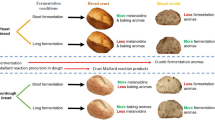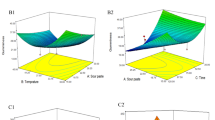Abstract
The quality of sweet flour pastes (SFP) produced via natural and temperature-controlled fermentation was investigated. Temperature-controlled fermentation shortened the production time with no significant (p<0.05) differences between sample types in amino nitrogen, total acid, reducing sugar, and organic acid concentrations observed at the end of fermentation. Naturally fermented SFP exhibited higher concentrations of free amino acids than temperature-controlled fermented SFP. Analysis of SFP volatile compounds showed that naturally fermented SFP samples had higher concentrations of aroma constituents. Ethyl palmitate was the dominant ester in SFP with a 5.2× higher content of ethyl palmitate than for naturally fermented SFP. In addition, 4-ethyl guaiacol and 4-vinyl guaiacol were only identified in naturally fermented SFP samples. Temperature-controlled fermentation accelerates the production process, and naturally fermented SFP exhibited a higher quality.
Similar content being viewed by others

References
Técher D, Martinez-Chois C, D’Innocenzo M, Laval-Gilly P, Bennasroune A, Foucaud L, Falla J. Novel perspectives to purify genomic DNA from high humic acid content and contaminated soils. Sep. Purif. Technol. 75: 81–86 (2010)
Krsek M, Wellington E. Comparison of different methods for the isolation and purification of total community DNA from soil. J. Microbiol. Meth. 39: 1–16 (1999)
Cho J-C, Lee D-H, Cho Y-C, Cho J-C, Kim S-J. Direct extraction of DNA from soil for amplification of 16S rRNA gene sequences by polymerase chain reaction. J. Microbiol. 34: 229–235 (1996)
Beganovié J, Pavunc AL, Gjuraèié K, Špoljarec M, Šuškovié J, Kos B. Improved sauerkraut production with probiotic strain Lactobacillus plantarum L4 and Leuconostoc mesenteroides LMG 7954. J. Food Sci. 76: 124–129 (2011)
Akolkar A, Durai D, Desai A. Halobacterium sp. SP1 (1) as a starter culture for accelerating fish sauce fermentation. J. Appl. Microbiol. 109: 44–53 (2010)
Cui R-Y, Zheng J, Wu C-D, Zhou R-Q. Effect of different halophilic microbial fermentation patterns on the volatile compound profiles and sensory properties of soy sauce moromi. Eur. Food Res. Technol. 239: 321–331 (2014)
Zhao J, Dai X, Liu X, Zhang H, Tang J, Chen W. Comparison of aroma compounds in naturally fermented and inoculated Chinese soybean pastes by GC-MS and GC-Olfactometry analysis. Food Control 22: 1008–1013 (2011)
Wiander B, Ryhänen E-L. Laboratory and large-scale fermentation of white cabbage into sauerkraut and sauerkraut juice by using starters in combination with mineral salt with a low NaCl content. Eur. Food Res. Technol. 220: 191–195 (2005)
Viander B, Mäki M, Palva A. Impact of low salt concentration, salt quality on natural large-scale sauerkraut fermentation. Food Microbiol. 20: 391–395 (2003)
Peñas E, Frias J, Gomez R, Vidal-Valverde C. High hydrostatic pressure can improve the microbial quality of sauerkraut during storage. Food Control 21: 524–528 (2010)
Johanningsmeier S, McFeeters RF, Fleming HP, Thompson RL. Effects of Leuconostoc mesenteroides starter culture on fermentation of cabbage with reduced salt concentrations. J. Food Sci. 72: M166-M172 (2007)
Feng J, Zhan X-B, Wang D, Zhang L-M, Lin C-C. An unstructured kinetic model to study NaCl effect on volatile ester fermentation by Candida etchellsii for soy sauce production. Biotechnol. Bioproc. E. 17: 242–249 (2012)
Kim J-S, Lee Y-S. A study of chemical characteristics of soy sauce and mixed soy sauce: chemical characteristics of soy sauce. Eur. Food Res. Technol. 227: 933–944 (2008)
Wu C, Liu C, He G, Huang J, Zhou R. Characterization of a multiple-stress tolerance Tetragenococcus halophilus and application as starter culture in Chinese Horsebean-Chili-Paste manufacture for quality improvement. Food Sci. Technol. Res. 19: 855–864 (2013)
Gao X, Cui C, Ren J, Zhao H, Zhao Q, Zhao M. Changes in the chemical composition of traditional Chines-type soy sauce at different stages of manufacture and its relation to taste. Int. J. Food Sci. Technol. 46: 243–249 (2011)
Schoenberger C, Krottenthaler M, Back W. Sensory and analytical characterization of nonvolatile taste-active compounds in bottom-fermented beers. Tech. Q. Master Brew. Assoc. Am. 39: 210–217 (2002)
Udomsil N, Rodtong S, Choi YJ, Hua Y, Yongsawatdigul J. Use of Tetragenococcus halophilus as a starter culture for flavor improvement in fish sauce fermentation. J. Agr. Food Chem. 59: 8401–8408 (2011)
Gao X, Sun P, Lu J, Jin Z. Characterization and formation mechanism of proteins in the secondary precipitate of soy sauce. Eur. Food Res. Technol. 237: 647–654 (2013)
Zarkadas CG, Gagnon C, Gleddie S, Khanizadeh S, Cober ER, Guillemette RJ. A ssessment of t he p rotein q uality of fourteen s oybean [ Glycine max (L.) Merr.] cultivars using amino acid analysis and two-dimensional electrophoresis. Food Res. Int. 40: 129–146 (2007)
Nishimura T, Kato H. Taste of free amino acids and peptides. Food Rev. Int. 4: 175–194 (1988)
Kirimura J, Shimizu A, Kimizuka A, Ninomiya T, Katsuya N. Contribution of peptides and amino acids to the taste of foods. J. Agr. Food Chem. 17: 689–695 (1969)
Breslin PA. Interactions among salty, sour and bitter compounds. Trends Food Sci.Tech. 7: 390–399 (1996)
Keast RS, Breslin PA. An overview of binary taste–taste interactions. Food Qual. Prefer. 14: 111–124 (2003)
Lee SJ, Ahn B. Comparison of volatile components in fermented soybean pastes using simultaneous distillation and extraction (SDE) with sensory characterisation. Food Chem. 114: 600–609 (2009)
Raghavendra T, Sayania D, Madamwar D. Synthesis of the’ green apple ester’ ethyl valerate in organic solvents by Candida rugosa lipase immobilized in MBGs in organic solvents: Effects of immobilization and reaction parameters. J. Mol. Catal. B-Enzym. 63: 31–38 (2010)
Zhang Y, Huang M, Tian H, Sun B, Wang J, Li Q. Preparation and aroma analysis of Chinese traditional fermented flour paste. Food Sci. Biotechnol. 23: 49–58 (2014)
Yamabe S, Kaneko K, Inoue H, Takita T. Maturation of fermented rice-koji miso can be monitored by an increase in fatty acid ethyl ester. Biosci. Biotechnol. Bioch. 68: 250–252 (2004)
Rocha SM, Rodrigues F, Coutinho P, Delgadillo I, Coimbra MA. Volatile composition of Baga red wine: Assessment of the identification of the wouldbe impact odourants. Anal. Chim. Acta 513: 257–262 (2004)
Ames JM, Macleod G. Volatile components of an unflavored textured soy protein. J. Food Sci. 49: 1552–1565 (1984)
Meng Y, Qiao Y, Liu C, Kang X, Li D, Hu J, Huang H. Effect of primary fermentation temperature on volatile comounds and quality of sweet flour paste. Chinese J. Food Sci. 31: 248–252 (2010)
Steinhaus M, Sinuco D, Polster J, Osorio C, Schieberle P. Characterization of the key aroma compounds in pink guava (Psidium guajava L.) by means of aroma re-engineering experiments and omission tests. J. Agr. Food Chem. 57: 2882–2888 (2009)
Kaneko S, Kumazawa K, Nishimura O. Comparison of key aroma compounds in five different types of Japanese soy sauces by aroma extract dilution analysis (AEDA). J. Agr. Food Chem. 60: 3831–3836 (2012)
Chung HY. Volatile components in fermented soybean (Glycine max) curds. J. Agr. Food Chem. 47: 2690–2696 (1999)
Wanakhachornkrai P, Lertsiri S. Comparison of determination method for volatile compounds in Thai soy sauce. Food Chem. 83: 619–629 (2003)
Fiddler W, Parker WE, Wasserman AE, Doerr RC. Thermal decomposition of ferulic acid. J. Agr. Food Chem. 15: 757–761 (1967)
Author information
Authors and Affiliations
Corresponding author
Rights and permissions
About this article
Cite this article
Deng, J., Wu, H. & Yang, Z. Quality comparison of sweet flour pastes produced via natural and temperature-controlled fermentation. Food Sci Biotechnol 24, 2059–2064 (2015). https://doi.org/10.1007/s10068-015-0274-x
Received:
Revised:
Accepted:
Published:
Issue Date:
DOI: https://doi.org/10.1007/s10068-015-0274-x



